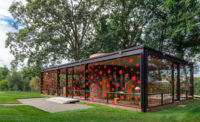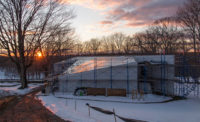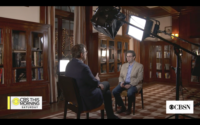While sculptures by the likes of Robert Rauschenberg, John Chamberlain, Bruce Nauman, and Robert Morris deserve permanent places of honor in a building designed by one of architecture’s legends, birds and rodents decidedly do not. Thanks to a major restoration of Philip Johnson’s Sculpture Gallery at the Glass House, these priceless works are safe again from the elements—and the wildlife—of New Canaan, Connecticut.
This month, the Sculpture Gallery reopens to the public after a two-year-long renovation that leaves the structure—one of 14 on the 49-acre museum property—with a new roof, updated lighting system, and fresh paint inside and out. Built in 1970 to house Philip Johnson’s personal collection, the gallery is thought to be inspired, in part, by the narrow streets and staircases of the Greek islands. Inside, a series of squares, offset from one another at 45-degree angles, are connected by shallow stairs and lead down to the lower galleries. (The steps are not up to current codes; visitors can only observe from the main landing.) During the day, sunshine streams in through the glazed roof, casting a shadow grid on the white walls and brick floors, while, at night, cold-cathode tube lights affixed to the steel structure overhead bathe the space in a peachy glow. It’s said Johnson found the effect so pleasing that he seriously considered moving his residence from the Glass House to the gallery. Ultimately, he decided against it, asking, “Where would I have put the sculpture?”
Time took its toll, and the Sculpture Gallery fell into disrepair: the steel was rusting, the lighting didn’t work, the gutter liners were failing, and several of the glass panels making up the skylights had been replaced with imperfect matches, allowing water inside. “We made sure none of the art was damaged,” says communications director Christa Carr, “but when it rained, we had buckets hidden behind the sculptures, and sometimes you’d come in and see birds flying or chipmunks running around.”
Brendan Tobin, the Glass House’s senior manager of buildings and grounds, oversaw the $2 million project, which kicked off in May 2015. Oldcastle BuildingEnvelope (an Architectural Record advertiser) donated and transported the custom UV-coated and insulated glass to rebuild the skylight system, working with legacy firm Philip Johnson Alan Ritchie Architects and contractor Nicholson & Galloway, both based in New York.
The project team removed the old glazing, as well as the coatings of all interior and exterior brick and steel, before installing and sealing the precisely fabricated glass. They also replaced the lighting with a new cold-cathode system modeled after the original, refurbished the vents along the top beam of the roof, and repainted all surfaces. Phase one ended in April, while further subgrade work to waterproof the perimeter will begin in July and take up to two months. Carr says it’s the largest capital project the museum has undertaken since opening in 2007, but already the staff is looking to the next endeavor: a renovation of the Brick House, constructed in the late 1950s opposite the Glass House and initially used as a guesthouse and study.
The restored Sculpture Gallery and overall Glass House museum reopen for the 2017 season on May 1 with the Julian Schnabel exhibition Paintings that I Hope Philip and David Would Like and, later in the month, Robert Indiana, ONE through ZERO.





















Post a comment to this article
Report Abusive Comment